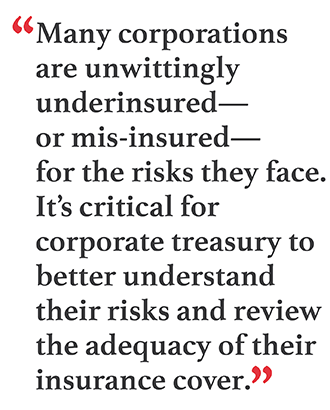
Large corporations have become so complex that many aredangerously underinsured for key business risks. It's a problem noone, either inside corporate leadership circles or in the insurancesector, knows how to fully solve. In some cases, corporate riskmanagers do not even realize the problem exists until a large lossoccurs.
|Businesses have become more and more complex for decades, asthey have expanded globally, engaged in extensive merger andacquisition (M&A) activity, and built cross-border sales andsupply chains. This complexity has been exacerbated in recent yearsby operational responses to the global financial crisis,technological innovations, the rollout of new regulations andcorporate governance initiatives in many jurisdictions, andinternal cost-cutting programs.
|Corporate complexity is mirrored in the increasing complexity ofinsurance policy contracts and how those policies respond todifferent types of loss. Insurers are redefining the scope of theirpolicies through new specifications on which causes of loss areinsured, which costs of incident response are covered, whichparties fall within definitions of “insured,” how the manyexclusions and extensions work together, how overlap betweendifferent policies is resolved—and the list goes on.
|The growing complexity and specificity in policy contracts havealso led to the emergence of so-called coverage “black spots” inthe commercial insurance sector. Corporate risk disclosures havefailed to keep pace with the high rate of business change, andcommercial insurance policies increasingly fail to reliably covercomplex risks. As a result, many businesses face significantexposures because their insurance coverage is inadequate. And forthe most part, the leadership teams at these companies are unawareof the risks they face where insurance no longer fits. They may notdiscover the gaps in their insurance until they suffer a big lossand their insurer rejects the claim.
||
Research Shows Significant Increases in Risk Complexity andLoss Volatility
An industrial-risk study carried out by Mactavish, inassociation with PwC, looked at the five-year period between 2009and 2014. It uncovered a significant increase in risk complexityfaced by many U.K. business sectors.
|More alarming, many of these risks were not adequately disclosedto, or understood by, insurers. We found that variations incontractual terms are on the increase. We discovered companies inwhich operational streamlining has reduced business resiliency. Andwe uncovered situations in which compressed timelines for productdevelopment have increased launch risk and blurred the traditionalboundaries between product and service offerings, opening companiesup to new types of claims.
| Our study predicted that insurerswould struggle to keep up with the rate of business change becauseof systemic weaknesses in how insurance is placed—in particular,because cost-cutting has reduced insurers' technical risk analysisand resulted in overly standardized policies. We also predictedthat this weakness in insurer processes would lead to an increasein the severity and volatility of both large losses and disputesbetween insurers and their customers.
Our study predicted that insurerswould struggle to keep up with the rate of business change becauseof systemic weaknesses in how insurance is placed—in particular,because cost-cutting has reduced insurers' technical risk analysisand resulted in overly standardized policies. We also predictedthat this weakness in insurer processes would lead to an increasein the severity and volatility of both large losses and disputesbetween insurers and their customers.
Recent insurer results suggest these projections have come topass. A Mactavish analysis of insurer balance sheets, reserveallocations, and annual results over the past few years shows aclear increase in the volatility of “man-made” losses forinsurers—in other words, insurance losses with a cause other thanweather events or natural disaster. The overall combined ratio ofAllianz Global Corporate & Specialty (AGCS), for example, roseto 105.2 percent in 2017. This number is equivalent to an operatingloss of 5 percent of premium income, and it's up approximately 4percentage points year-on-year, despite a significant reduction insmaller attritional claims over the same period.
|Such volatility in man-made losses is materially adding tolosses stemming from natural catastrophes, which are alsoincreasing, due in part to climate change. This creates a difficultsituation for insurance companies, whose profitability has taken abig hit in both areas.
||
Black Spots of Insurer Understanding
To date, underwriting black spots have been most apparent inareas like construction professional indemnity (PI). In thismarket, a long period of attractive insurance pricing coincidedwith dramatically increasing complexity of risks. Smaller companieswere getting involved in higher-profile projects; complexcontracting and joint venture arrangements became commonplace; andregulatory developments impacted projects such as sports stadia orhigh-rise cladding. All these circumstances increased thecomplexity of PI risks in the construction industry, leading topoor underwriting results and sustained losses for insurers.
|The situation came to a head late last year, prompting severalunderwriters to withdraw altogether from writing PI risk in thesector. Those insurers that stayed in the market are reluctant tounderwrite risks on anything other than the most restrictedterms.
|We anticipate the emergence of further black spots in 2019across the wider industrial landscape. For example, we believe thatmarket conditions for directors and officers (D&O) liabilitycoverage will rapidly worsen in the second half of this year.Underwriting D&O policies is notoriously complex, and practiceshave been put to the test by the “Me Too” movement and otherscandals in recent years, with both claims frequency and averageclaim costs rising rapidly. At the same time, issues such as Brexitwill open boards to a new range of potential allegations ofmismanagement, as well as to new regulatory difficulties. Ifinsurers don't fully anticipate these emerging D&O risks,subsequent losses will exacerbate the already-hardening marketdriven by several years of underwriting losses.
|Cost increases and capacity reductions have started to hitcompanies operating in insurance black spots. This is only going toworsen in the coming year, and companies can expect to facesometimes-insidious changes that will reduce the value of theirinsurance cover. These changes might not always be as noticeable asreduced limits or increased deductibles. Instead, they will oftencome in by way of new geographic limitations; new exclusions forcertain types of work in PI or for categories of D&O claimssuch as derivative claims against individuals; or even hiddenwithin tweaked policy definitions.
|In some cases, the consequences for the price and availabilityof specific types of coverage in certain areas may be extreme—forexample, some construction PI cases in recent months have seenpremiums more than triple, and simultaneous reductions in coveragemean the underlying rate actually being paid by the client hasincreased by more than six times.
||
Corporate Treasury, Finance, and Risk Management in theCrosshairs
Much of the onus for protecting a company against these types ofrisks has been placed on the shoulders of corporate treasurers,finance managers, and the risk function—in other words, personnelwho do not specialize in insurance or legal matters.
|The challenge is that advisers such as insurance brokers may notbe any better equipped to understand the risks to theirincreasingly complex corporate customers, so they may not be ableto recommend the appropriate insurance coverage, either. Nor isinsurance placement typically a focus for internal or externalauditors. Together, these factors create a dangerous hole in manyorganizations' governance practices.
|As businesses continue to become more complex, and as this riskcomplexity filters through to insurers in the form of changes toclaims profiles, companies need more than ever before to addressthe tightening of insurance supply.
|Whoever in the organization is responsible for corporate riskmanagement—whether treasury, finance, or a separate risk managementfunction—must ensure on placement that the coverage they arepurchasing matches with the company's risk and executives'expectations, in order to avoid being the victim of both a rejectedclaim and a subsequent knee-jerk restriction of cover.
|Unfortunately, many companies are unable to effectively estimatetheir risks or to measure the degree to which their insurancepolicies—being limited to increasingly standard off-the-shelfpolicies—actually cover those risks. This problem is borne out bydecades of Mactavish research demonstrating rising levels oflitigation and disputes between all parties in the insurance chain:Our research shows that nearly half of all large insurance claimstoday are disputed by insurers.
|It is plain to see that many corporations are unwittinglyunderinsured—or mis-insured—for the risks they face.
||
What to Do About It
In this climate, it's critical for the corporate treasury,finance, and risk management functions to better understand theirrisks and review the adequacy of their insurance cover. They alsoneed to understand how to communicate their risk favorably, to meetall their legal obligations and to clarify the terms of theirinsurance coverage before it is too late. This communication shouldinclude: first, a major focus on identifying and documentingunusual aspects of the business model that may lead to anon-standard risk profile and, second, properly stress-testingpolicy detail against the known major loss scenarios.
|Taking these steps will be important, even necessary, asdeveloping losses begin outstripping the financial reservesinsurers have allocated to pay for them. Coverage availability willbecome tighter in many markets over the next year or two.Limitations in coverage will lead to wild, punitive shifts inpricing and available limits—particularly in black spot sectors andfor companies for which risk information is poor, irrespective ofhow well the business is actually managed.
|Companies need to act now to mitigate the risk that theirinsurance firms will fail to respond when they're most needed.
|
 Bruce Hepburn is theCEO of Mactavish, the U.K.'s leading independent expert oninsurance placement and disputes, which has been operating in thecommercial insurance sector for more than 15 years. Mactavish hasbeen closely involved with the project to reform commercialinsurance law in the U.K., an eight-year program that culminated inthe Insurance Act of 2015.
Bruce Hepburn is theCEO of Mactavish, the U.K.'s leading independent expert oninsurance placement and disputes, which has been operating in thecommercial insurance sector for more than 15 years. Mactavish hasbeen closely involved with the project to reform commercialinsurance law in the U.K., an eight-year program that culminated inthe Insurance Act of 2015.
Complete your profile to continue reading and get FREE access to Treasury & Risk, part of your ALM digital membership.
Your access to unlimited Treasury & Risk content isn’t changing.
Once you are an ALM digital member, you’ll receive:
- Critical Treasury & Risk information including in-depth analysis of treasury and finance best practices, case studies with corporate innovators, informative newsletters, educational webcasts and videos, and resources from industry leaders.
- Exclusive discounts on ALM and Treasury & Risk events.
- Access to other award-winning ALM websites including PropertyCasualty360.com and Law.com.
*May exclude premium content
Already have an account? Sign In
© 2024 ALM Global, LLC, All Rights Reserved. Request academic re-use from www.copyright.com. All other uses, submit a request to [email protected]. For more information visit Asset & Logo Licensing.







